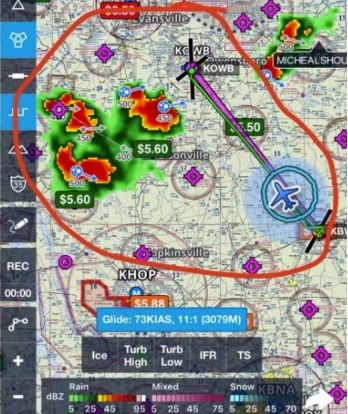NTSB publishes report detailing crash that killed Kentucky Eagle Scout and instructor
EVANSVILLE — At 10:40 p.m. on Sept. 27, a young flight instructor and his student were cruising at an altitude of 4,500 feet in a single-engine Piper PA28 aircraft, conducting a nighttime cross-country flight over Kentucky.
Nine minutes later, the Piper's transponder ceased to operate: The aircraft and its two occupants, 22-year-old instructor Timothy McKellar Jr. and 18-year-old Connor Ward Quisenberry, were now missing.
The next day, searchers located a debris field southwest of Whitefield, Kentucky, and confirmed their worst fears: McKellar and Quisenberry had both perished in a crash.
A new report released by the National Transportation Safety Board and an analysis of flight-tracking data reveals additional information about how the pair's cross-country flight ended in a tragedy that rocked the tight-knit community of Beaver Dam, Kentucky, which Quisenberry − an Eagle Scout − called home.
'Pretty extreme turbulence'
Sept. 27 marked the first time McKellar, an instructor at Owensboro-based Eagle Flight Academy, flew with Quisenberry, according to the NTSB. At 9:55 p.m., the pair departed Bowling Green–Warren County Regional Airport en route to Owensboro.
The Piper PA28 aircraft McKellar and Quisenberry operated featured an ADS-B transponder – a device that determines a plane's location via satellite and periodically broadcasts flight information to air traffic controllers and other data recipients.
ADS-B data compiled by FlightAware, an aviation tracking firm, shows McKellar and Quisenberry conducted two touch-and-go landings in Bowling Green before the pair began their cross-country flight on Sept. 27.
Then they took off for good, hoping to conclude hours of flight instruction.
"The airplane climbed to 4,500 ft (mean sea level) and proceeded on a northwesterly course toward Owensboro/Daviess County Regional Airport... on a visual flight rules flight plan," the NTSB Aviation Investigation Preliminary Report states.
At 10:15 p.m., McKellar authored a social media post from the cockpit, one of several posts that have since drawn criticism from the aviation community. The 10:15 p.m. post depicted radar weather imagery and the Piper's planned route to Owensboro, according to the NTSB.
Critically, the radar returns showed large storm cells floating to both the left and the right of McKellar's and Quisenberry's route.

By 10:44 p.m., an air traffic controller advised McKellar of "heavy to extreme precipitation" at the airplane's 9 o'clock position, the NTSB determined upon reviewing radio communications.
Transponder data showed the Piper continued to fly a northwesterly heading, and at 10:46 p.m., McKellar requested clearance to adopt instrument flight rules.
According to the Federal Aviation Administration, instrument flight rules allow a properly certified pilot to operate an aircraft even when meteorological conditions obstruct visual reference points.
"The controller issued the clearance and provided an easterly vector to assist the flight in getting out of the weather," the NTSB report states. "The flight instructor [McKellar] stated to the controller that the airplane was 'getting blown around like crazy.'"
The aircraft's transponder showed it turning northwest before entering a "right circling turn," the NTSB found.
When an air traffic controller again instructed McKellar to adopt a heading of 90 degrees, or due east, McKellar reportedly responded by saying they were in "pretty extreme turbulence."
From there, investigators determined the aircraft continued a rightward turn while simultaneously losing altitude: "No further communications were received from the flight instructor," the NTSB report states.
According to FlightAware's log of ADS-B transponder data, the Piper last beamed a signal logging its horizontal speed, vertical speed, heading, altitude, and location at 10:49 p.m.
Searchers later located a debris field about 1,000 feet northwest of the Piper's last known position, not far from New Panther Creek Church ‒ about a six-minute drive from Whitesville.
Aircraft thoroughly examined, though no crash-causing faults found during preliminary investigation
NTSB investigators said they located all of the Piper's major components, save for the left portion of its stabilator. The aircraft's fuselage had separated behind the rear seats. The cockpit, engine and right wing were found together.
"The wreckage was recovered to a salvage facility for further examination," the report states. "Examination of the engine revealed that the fixed-pitch propeller remained attached to the crankshaft propeller flange, and both propeller blades appeared straight. The engine displayed impact damage."
Federal investigators found no anomalies inside the engine's cylinders. The magnetos were tightly installed and, when rotated using an electric drill, still produced sparks.
"Examination of the engine did not reveal any pre-accident anomalies or malfunctions that would have precluded normal operation," the investigators concluded.
The NTSB's preliminary report does not attribute a cause to the fatal Sept. 27 crash. In September, an NTSB spokeswoman noted the presence of severe weather and its role in complicating the aircraft's return flight, but she noted all findings were preliminary and did not establish cause.
Quisenberry had recently graduated from Ohio County High School prior to the crash, according to his obituary. After graduating, Quisenberry attended Owensboro Community College and obtained his student pilot's license.
"He loved flying, all sports, the beach and spending time with his family and friends," Quisenberry's obituary states in part. "Connor was a very active member of Hartford Christian Church."
McKellar loved “all things fast: lifted and diesel trucks, airplanes and motorcycles,” his obituary states. “Junior never met a stranger, made those around him laugh (and) loved to entertain.”
But what of Eagle Flight Academy, where Quisenberry took lessons, and McKellar taught?
The once-bustling aviation center is now up for sale, according to a recent post on its official Facebook page.
"Is there anyone out there that would like to buy a flight school?" the post reads, in part. "We will be selling most everything."
Houston Harwood can be contacted at houston.harwood@courierpress.com.
This article originally appeared on Evansville Courier & Press: NTSB publishes report detailing deadly Kentucky plane crash
